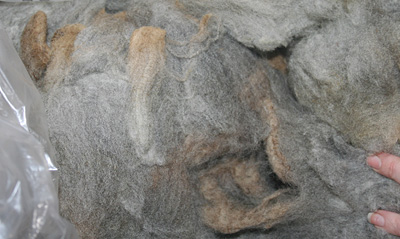  You’re
about to do it. You are at a fiber festival.
You’ve found yourself just outside
of the fleece tent. All the wool fumes have finally
gotten into your head and made you decide that
you need a fleece. In fact, you need one right
now! But you don’t want to take home
the wrong fleece or a bad one… You’re
about to do it. You are at a fiber festival.
You’ve found yourself just outside
of the fleece tent. All the wool fumes have finally
gotten into your head and made you decide that
you need a fleece. In fact, you need one right
now! But you don’t want to take home
the wrong fleece or a bad one…
I’ve come up with a check list for you.
Something that you can take with you to the fleece
barn and make sure you aren’t getting the
wrong fleece.
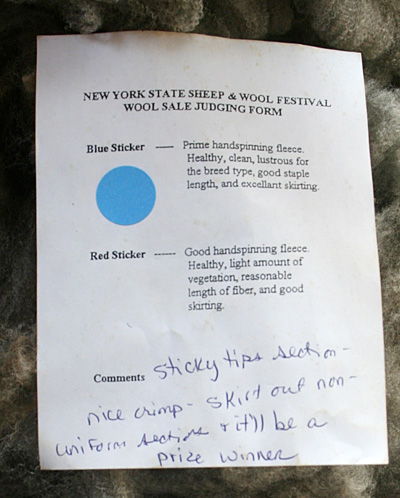  Before
you can start through the checklist, knowing
what breed or type of fleece you want is important.
You don’t want to indiscriminately
go through and start checking all fleeces. Start
with figuring out what you want from a fleece.
Pick a breed or a few breeds. Here’s a
quick guideline that obviously doesn’t
cover all the breeds you’ll find, but it
has some of the most common ones. Don’t
discount the cross breeds; the combination of
two breeds often gets you characteristics in
one fleece that can’t be found in a single
breed. Before
you can start through the checklist, knowing
what breed or type of fleece you want is important.
You don’t want to indiscriminately
go through and start checking all fleeces. Start
with figuring out what you want from a fleece.
Pick a breed or a few breeds. Here’s a
quick guideline that obviously doesn’t
cover all the breeds you’ll find, but it
has some of the most common ones. Don’t
discount the cross breeds; the combination of
two breeds often gets you characteristics in
one fleece that can’t be found in a single
breed.
Super
Soft: Merino, California Variegated
Mutant (CVM), Cormo, Blue Faced Leicester (BFL)
Curly locks: Cotswold, BFL,
Wensleydale, Mohair
Shine: Cotswold, BFL, Wennsleydale, Mohair
Hard wearing: Romney, Coopworth
Naturally superwash: Shropshire and Dorset (meat
breeds)
You will find many more
than this. It all depends on the festival or
farm you are visiting. I’ve
got an amazing Cormo/Romney fleece that I’m
hoarding. Each sheep is at a different
end of the softness spectrum but the 2 together
really is lending itself to a beautiful fleece.
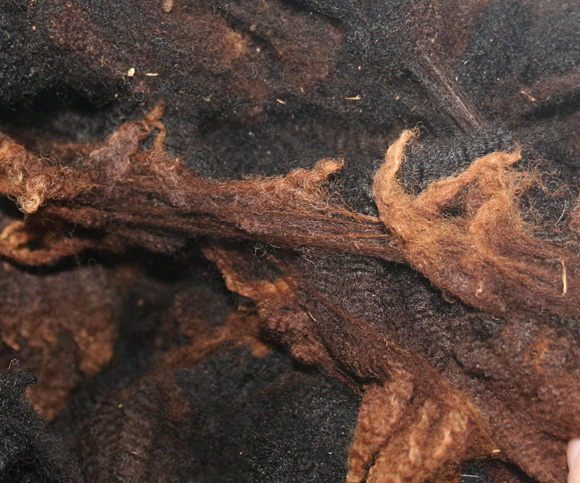
When I shop for a fleece,
I know what I want by look and feel. When I
touch a fleece I think I need, that’s
when I stop to do a few tests. Here is
a list of things to think about when interviewing
a potential fleece:
- Look. Is it a
color you want? Has it yellowed? (this can
be bad because the yellow doesn’t always
wash out and can mean a problem) Does it have
the shine or luster you want?
- Sometimes
a bargain is not really a bargain. I admit to buying
the fleece with the low price tag. It’s pretty, it’s nice, it’s
cheap…. It has a ton of VM but that
won’t be so bad…..It’s still
sitting there. If you have patience for
VM then by all means, take the deal. If not,
pass it by and get a fleece you will actually
want to use.
Here’s an extra
thought on VM and dung tags:
The outer parts and edges of a fleece are generally
rolled to the inside – meaning the inside
is the side that has all the dung tags and all
the VM (vegetable matter). I’m not
a fan of dung tags and if I see too many, no
matter how nice the fleece is, I’ll walk
away. Same for the VM. Dung needs to be picked
off but VM is picked, washed, or carded out. VM
is inevitable but some of the sheep are not coated
and have a ton of it mixed within the fleece. Know
your limitations of patience.
- Feel. Is it soft?
[photo –cormo] Don’t
worry if it’s dripping with lanolin.
It will come out when you wash it. What are
you expecting from your fleece? Harsh, long
wearing or soft and buttery? Somewhere
in between? Your eyes and your hands are going
to be the best method to give you an idea of
what you want. Once you settle on something
and the look and feel is good to you, this
is when we get really picky.
- Look
at the farmer’s tag. See the
breed. Is it on your list of desirables?
(though this shouldn't be a deal breaker
if it passes your other tests). Has the farmer
made any notes? Notes like “lovely
fleece”, “Great for a beginner” only
mean something if you are familiar with the
farmer and her evaluation methods of a fleece.
More important are “coated sheep” (which
means less VM), “sheep was sick” at
some point (walk away now), “high (or
low) VM”. These are all the kinds
of helpful notes that will help you decide.
Not to mention the tag will have a per pound
price and notation as to whether the farmer
will allow you to buy by the pound, the half
fleece or the whole fleece. Knowing how
much fleece you want is a good thing in this
situation.
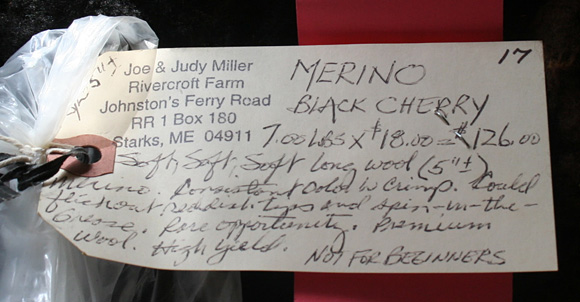
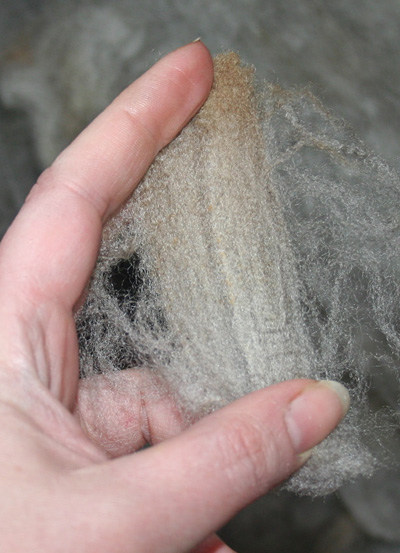  So far, so good, you
are still loving this fleece. Let’s give
it the final tests. So far, so good, you
are still loving this fleece. Let’s give
it the final tests.
5.
Lock test #1: crimp
Pull out a lock. You
want a full lock from the tip to the base,
at least a thumb-sized sample just to be able to
clearly see the crimp.
What
does the crimp look like? Is there a healthy
crimp to it or does it sag? A nice healthy crimp
is what you are looking for. Crimps vary from
breed to breed but there is a huge difference
in uniform crimps and limpness. Limpness or uneven
crimp could mean the animal was ill at some point
while the fleece was growing or is ill still.
(if it’s uneven crimp, sometimes if you
look at it while holding the lock taught, you
will see a lighter area where the animal was
sick and the fleece was compromised; it will
break at this spot making for a poor yarn)
Length. Is it super short
or super long? Either one could present problems
in spinning or how you are planning on preparing
the fiber. Neither
one is necessarily bad, just be aware of what
you are getting yourself into.
A note on second cuts:
This is the point where you can see second cuts.
Second cuts are very short pieces that were
cut in a second pass over the sheep after cutting
the long parts (the majority of the fleece) off. Many fleeces
have some second cuts, but you don’t want a lot of them.
Second cuts need to be thrown away since they’re
far too short to be included in a good yarn,
so you don’t want to see a fleece riddled
with them.
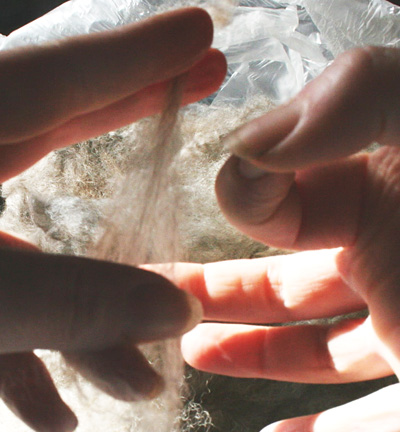  Lock test #2: sound Lock test #2: sound
The
ping test. This one may seem silly
but it works.
Get a smaller section of
the lock you pulled out, hold it taut between
two fingers ---> and using another finger,
flick the lock. Does it snap or make twangy,
snappy noises when you do this? Or does it have
a ping? Healthy fibers will make a ping noise.
If this ping test
takes too much coordination, you can get the
same result by snapping the lock between two
hands [see below]. You're
still looking for the same pinging sound instead
of a snap or a fizzle.
Once you do this
a few times, you'll know what I mean by the sounds.
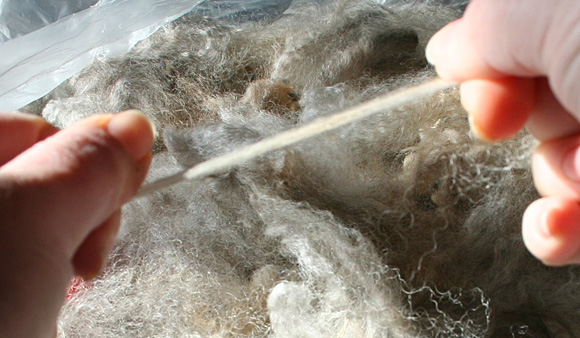
This may seem like a
really lengthy and time-consuming way to pick
out a fleece. But as you do it
more, it really doesn’t take that long.
A lot of fleeces get weeded out quickly in the
first 4 steps. Once you get used to the techniques
in steps #5 and #6, it will go faster.
CHECKLIST
__ Look (color, shine, VM)
__ Touch (softness)
__ Read (helpful notes and pricing)
__ Lock tests (remember to look for second cuts)
__ Crimp (uniform)
__ Length (the long and short of it)
__ Ping test (how does it sound)
|
|

